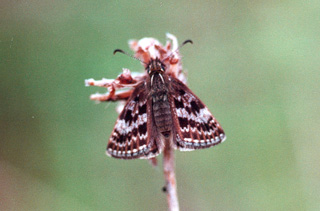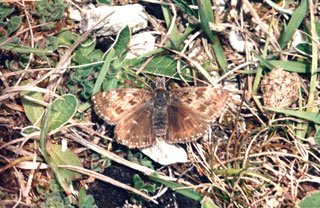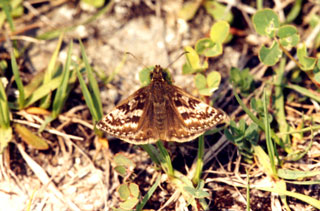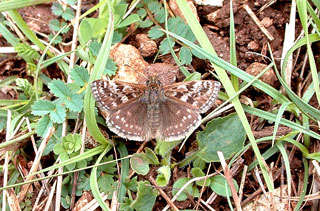Identification
Small: wingspan c. 30 mm
Both sexes are a dingy grey-brown. The forewings are obscurely patterned with a series of lighter and darker irregular bands or blotches arranged parallel to the outer edge of the wing. There is a row of small white dots running along the outside of the wings. The hind wings are largely unpatterned except for a double row of small white dots around the outside and n oblique off white bar in their centres. The underside of the forewings is barely patterned and those of the hind wings are a dull reflection of the upper surface. Males are rather browner than the females although they become greyer with age.
IMAGES COURTESY STEVE SHROUD (C)




Behaviour and life history
Dingy Skippers live in small colonies in sheltered situations where they spend much of their time sunning themselves on the bare soil or on low vegetation. On sunny days, they are very active fliers, settling frequently to bask in the sun with their wings outstretched. They do not adopt the angled forewing pose favoured by the Small and Large Skippers and hold both sets out horizontally. Eggs are laid in June or early July with the caterpillars emerging in late July or August. The caterpillar transforms into a chrysalis over winter inside a silken tent the caterpillar spins around itself low down in vegetation. Adults emerge in Late April or early May. Its foodplant in Plymouth is probably restricted to Birds-foot Trefoil, Lotus corniculatus.
Where to look for it
This species favours warm, sheltered habitats with rather skeletal vegetation which must include its larval foodplant. It favours abandoned quarries, railway lines and embankments, and derelict industrial wasteland. The best places to look for the butterfly in Plymouth are the old limestone quarries of Plymstock and the abandoned Elburton railway track.
Distribution and status
Rather uncommon and very local in its distribution. Populations in Plymouth have declined markedly over the last ten years with the development of their favoured derelict sites.
Similar species
The Dingy Skipper is most likely to be mistaken for a nondescript moth and should not be confused with any other butterfly in Plymouth. It is most likely to be confused with the Burnet Companion moth, Euclidia glyphica, which flies about during the day in same habitats as the Dingy Skipper. However, a prominent transverse orange-brown band on either hind wing easily distinguishes the moth.

